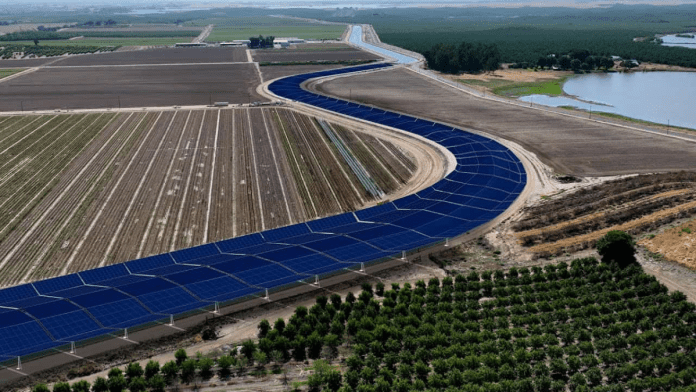🕒 Last updated on October 17, 2025
California is changing how renewable energy and water conservation work together. In the state’s Central Valley, a new $20 million project called Project Nexus has transformed regular water canals into clean power generators. Instead of using farmlands or open spaces for solar farms, engineers have installed solar panels directly above canals, making the same area produce both electricity and water savings.
This project marks the first canal-top solar system in California and only the second in the United States. Completed in August 2025, it shows how clean energy and water management can work side by side to solve some of California’s biggest challenges — drought and the need for more renewable power.
A New Way to Make Clean Energy
Project Nexus was launched across parts of the Turlock Irrigation District (TID) canal network. It began earlier in 2025 and was completed in two phases. The first, a smaller 20-foot-wide section, was finished in March. The second, a much larger 110-foot-wide span, was completed and switched on in late August.
Together, the two canopy-covered canal sections form a 1.6-megawatt solar installation that now feeds electricity directly into the TID grid. The two different designs are being tested to see how structure and width affect cost, strength, and power generation.
The concept of canal-top solar power isn’t entirely new. It was inspired by an earlier 1.3-megawatt system built in Arizona’s Gila River Indian Community, completed in 2024. That smaller project showed that solar panels built over water tend to stay cooler than panels placed on land. This cooling effect helps them generate more electricity, since heat normally reduces solar efficiency.
California will stop using coal power next month in a major clean energy milestone
Saving Water While Producing Power
The cooling benefit is only one part of the success. The shade from the solar panels helps reduce water evaporation and limits algae growth in the canals, which in turn cuts down on maintenance costs. For a drought-prone state like California, this combination of clean energy and water conservation is especially valuable.
A study found that if all 4,000 miles of California’s canals were covered with solar panels, the state could generate enough electricity to power around two million homes every year. It could also save enough water to supply another two million homes annually, while preventing the use of nearly 50,000 acres of land that would otherwise be needed for ground-based solar farms.
Water canal expert David DeJong, director of the Pima-Maricopa Irrigation Project, has praised this approach, saying that it makes sense to use canal space for solar energy instead of disturbing valuable land that might have cultural or natural importance.
The Promise and Research Behind Solar Canals
Teams from the University of California, Merced, are collecting real-time data from Project Nexus to measure how much energy and water it saves. They are studying temperature effects, efficiency levels, and maintenance needs to better understand how to expand this model across other areas.
The system was built by Solar AquaGrid, a company leading efforts to introduce canal-top solar technology throughout California. The firm is working with irrigation districts and energy planners to design systems that can be quickly installed over existing canals.
This setup has additional benefits beyond power and water savings. Since canals often run close to existing power lines, connecting solar systems to the grid becomes simpler and cheaper compared to building new solar farms in remote areas. Using already-developed land also avoids conflicts with agriculture, wildlife, and community development.
Dual-tower solar thermal plant begins operation in China’s Gobi Desert
Interest in California’s solar canals has spread internationally. Countries including Spain, Romania, Vietnam, Brazil, and Ukraine have shown interest in adapting this idea after learning about its success in the Central Valley.
Challenges and Costs of Building Solar Canals
While the benefits are clear, the technology comes with challenges. Building canal-top solar systems is more expensive and complex than traditional solar farms. The structures need additional steel and concrete for support, especially when spanning wide canals. Some of the larger systems may require underwater supports, which could interfere with water flow.
For these reasons, Arizona’s Salt River Project decided not to move forward with its own pilot after comparing costs with regular solar farms. However, experts believe that the long-term gains from water savings and higher panel efficiency could outweigh the initial costs.
Architect and canal-top solar specialist Ben Lepley, founder of sustainable design firm Tectonicus, explained that although the investment is higher at the start, projects like these can deliver low-cost power in the long run. He added that canal-top solar installations provide stability over decades because of their efficient power generation and reduced land-use pressure.
Even with the higher cost, Project Nexus has already proven that solar canals can produce real results. By combining energy production with water conservation and land protection, California has taken a major step toward smarter, more efficient renewable energy development.

